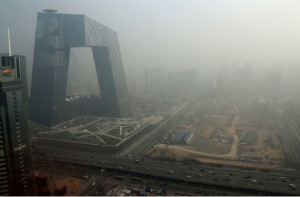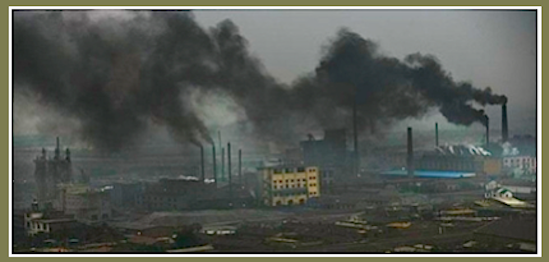27 December | FLUORIDE & HEALTH, FLUORIDE POLLUTION | admin
FLUORINE IN CHINESE COALS.
“In these regions the incidence of dental fluorosis
has a significant positive correlation with the
concentration of fluoride in coal…”

→ FLUORINE IN CHINESE COALS ←
Daishe Wu,a,b,c Baoshan Zheng,a Xiuyi Tang,d Shehong Li,
a Binbin Wang, a Mingshi Wang,a,b Guiyang, China
“…Even though the fluorine content of most coals in China is not high,
much more attention should be given to the fluoride pollution
caused by improper (unvented) coal-burning and the
widespread household use of high- fluoride coal-clay…”
CHINA PLANS TO SPEND $275 BILLION
TO COMBAT POLLUTION CRISIS
31 JULY 2013
Written by Aviva Shen
China’s air pollution levels have reached dire levels, even breaking the upper limits of the Air Quality Index earlier this year. In a sign the government is serious about tackling this crisis, The China Daily announced Thursday that China will spend $275 billion over the next five years to reduce emissions and launch anti-pollution programs.
The funds, which exceed the total economic output of Hong Kong last year, will target emissions in the densely populated area surrounding Beijing, where residents have suffered through off-the-charts pollution and all its accompanying illnesses. Air pollution caused more than 1.2 million premature deaths in China in just one year, while some Beijing schools are building air-purified domes over playgrounds so children can play “outside” safely. Anti-pollution protests have grown more and more prevalent all over the country.
These unsustainable conditions are directly linked to China’s rapid industrialization. Most of Beijing’s pollution stems from factories and power plants outside the city. China’s coal production has tripled in the past ten years as the nation’s energy consumption has exploded. The Chinese government, up til this year, has aggressively encouraged economic growth at the expense of the environment and public health.
But now that the environmental repercussions cannot be ignored, the government has done a hard about-face. New promised anti-pollution measures include speedy installation of pollution control equipment on coal-fuelled refineries, restrictions on high energy consumption industries like steel, cement and glass, and use legal action to force industries to upgrade their emissions standards.
Before Thursday’s announcement, China had already pledged $16 billion to specifically help Beijing build and update sewage and garbage treatment, plant new forests and curb illegal construction.
The nation also invested twice as much as the U.S. in clean energy projects last year.
This post was originally published at ClimateProgress.
Read more:
http://www.care2.com/causes/china-plans-to-spend-275-billion-to-combat-pollution-crisis.html#ixzz2amQosYLR
See also:
⇓ Please note the difference ⇓
COAL- Steaming & Coking
FLUOROSIS — COAL BURNING – CHINA

106 Fluoride Vol. 36 No. 2 106-112 2003 Research Report
For Correspondence: Prof Wuyi Wang, Institute of
Geographical Sciences and Natural Resources
Research, Chinese Academy of Sciences,
Beijing 100101, China. E-mail:
wangwy@igsnrr.ac.cn
ENVIRONMENTAL EPIDEMIC CHARACTERISTICS
OF COAL BURNING ENDEMIC FLUOROSIS AND
THE SAFETY THRESHOLD OF COAL FLUORIDE IN CHINA
Yonghua Li, Wuyi Wang, a Linsheng Yang, Hairong Li
Beijing, China
SUMMARY: Data on coal-burning endemic fluorosis throughout China and on the exposure-response relationship between concentrations of fluoride determined in coal samples and the prevalence of dental fluorosis reported from 17 representative surveillance stations in Southwest China were used to estimate the safety threshold for coal fluoride. Coal-burning endemic fluorosis occurs mainly in the mountainous areas of this part of China, where the prevalence of the disease is closely linked to geochemical parameters of the local environment. In these regions the incidence of dental fluorosis has a significant positive correlation with the concentration of fluoride in coal. The safety threshold of coal fluoride is estimated to be 190 mg/kg by the criterion of 0% incidence of dental fluorosis.
Keywords: China; Coal fluoride; Endemic fluorosis; Safety threshold.
INTRODUCTION
Fluorine (F), the most electronegative and reactive of the halogens, is a common chemical element in the earth’s crust in combined form. F concentrations in rocks and soils are well documented, but data on the F concentration in coal are relatively limited.
1-4 Swaine reported the total F concentration in coal ranges from 20 to 500 mg/kg.
5 Statistical data indicate that the mean concentration of F in coal worldwide is 80 mg/kg, but in China it is 200 mg/kg.
6 In the mountainous areas of Southwest China, it is even higher— up to 3106 mg/kg in local coal.
7 Fluoride in coal can be released into the ambient environment as atmospheric F, waterborne F, and residue F during mining, handling, and combustion.
6-8 In Southwest China, F




